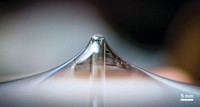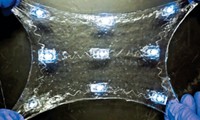Advertisement
Grab your lab coat. Let's get started
Welcome!
Welcome!
Create an account below to get 6 C&EN articles per month, receive newsletters and more - all free.
It seems this is your first time logging in online. Please enter the following information to continue.
As an ACS member you automatically get access to this site. All we need is few more details to create your reading experience.
Not you? Sign in with a different account.
Not you? Sign in with a different account.
ERROR 1
ERROR 1
ERROR 2
ERROR 2
ERROR 2
ERROR 2
ERROR 2
Password and Confirm password must match.
If you have an ACS member number, please enter it here so we can link this account to your membership. (optional)
ERROR 2
ACS values your privacy. By submitting your information, you are gaining access to C&EN and subscribing to our weekly newsletter. We use the information you provide to make your reading experience better, and we will never sell your data to third party members.
Materials
Just Add Water: DNA Hydrogel Remembers Its Original Shape When Resubmerged
Unique material could find use for drug delivery and in electrical switches and robotics
by Lauren K. Wolf
December 7, 2012

A new DNA-based hydrogel collapses into a liquidlike puddle when taken out of water and regains its original shape when plunged back in, according to a report in Nature Nanotechnology (DOI: 10.1038/nnano.2012.211). Although the researchers who discovered the unique material aren’t yet sure why it’s capable of such a feat, they think it could eventually be used for drug delivery and in electrical switches and robotics.
The research team, led by Dan Luo of Cornell University, has a lot of experience with DNA hydrogels. Previously, the scientists fabricated one type of hydrogel using branched DNA and an enzyme called a T4 ligase that cross-linked the DNA together chemically (Nat. Mater., DOI: 10.1038/nmat1741). Although those gels could be molded into a variety of shapes, they couldn’t convert between solidlike and liquidlike states as the new gels do.
To make the shape-remembering material, Luo, grad students Jong Bum Lee and Songming Peng, and coworkers extended and wove together single-stranded DNA with Φ29, a bacteriophage polymerase. Because the researchers manipulated the enzyme to make a small percentage of complementary DNA sequences in each gel batch, Luo explains, some of the synthesized strands hydrogen bond to one another. In general, though, the hydrogel is held together by the physical entanglement of extraordinarily long strands, he adds. The average strand is 140,000 DNA bases long.
These properties make this “arguably the softest gel ever made,” Luo contends, adding that his team believes the material’s softness is also what lends it its unique ability. “It’s so soft, when it’s out of water, gravity pulls it out of shape,” he explains. “But in water, buoyancy balances out gravity,” and the gel retakes its original shape.
The team is currently conducting computer simulations and modeling to better understand the phenomenon.
Because the gels do something that substances in nature can’t—liquify, lose shape, and then resolidify and take shape—Luo’s group has classified them as “metamaterials.” In the past, that term has been applied to inorganic materials with unusual electromagnetic or acoustic properties, like substances that can cloak objects from detection.
In a commentary accompanying the new report, Ju Li and Liyuan Bai, engineers at Massachusetts Institute of Technology, liken the unique hydrogel to the T-1000 robot assassin in the film “Terminator 2: Judgement Day,” which could liquefy, move through narrow openings, and then retake a solid humanlike shape.
Luo’s group can’t make their hydrogels perform that trick just yet. But the scientists have demonstrated its utility in an electrical circuit. To do so, they impregnated the hydrogel with gold nanoparticles. Then, the researchers placed the gel in a fluid channel with metal electrodes on either end and removed its surrounding water so that the material liquefied. At this point, the gel filled the channel and connected the circuit, allowing current to flow. When the researchers added water, the gel became solidlike and shrank away from the electrodes, turning the current off.
“This research not only opens a new avenue to develop intelligent metamaterials,” says Yong Wang, a chemical engineer at the University of Connecticut, Storrs, “it also holds great potential to have a broad impact on areas such as drug delivery. Excitingly, it demonstrates how human beings can use natural materials to create things beyond what evolution can do.”





Join the conversation
Contact the reporter
Submit a Letter to the Editor for publication
Engage with us on Twitter